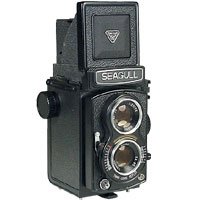How to Load a 35mm Camera
I remember walking into my first photography class and freaking out when I realized it wasn't digital cameras I'd be working with but manual cameras. I struggled for days trying to load the film correctly in the camera and got frustrated on many occasions. I couldn't even tell you how many rolls of film I wasted until I finally got the technique down packed. However, now going into my second year as a photography student, I have become a pro at loading film and I'm going to share my secrets with you.
First, you have to pull up on the film rewind knob located on the top, left hand side of the camera when you look at the back of the camera. When you look inside the back of the camera, on the left you will see the film chamber. Place the film inside the chamber with the film strip facing towards the middle of the camera back and push down the film rewind knob. This will lock the film in place so it won't move around.
Next, pull the film strip out only until it reaches the film reel which is the reel farthest to the right in the back of the camera. On the film reel there are thin slots which the film goes into. You want to make sure that the film goes into the farthest visible slot and push the film into the slot just a little bit. It's important to make sure that the film sprockets align correctly because that is what makes the film wind forward. The film sprockets are located on the sprocket reel which is to the left of the film reel. Once the sprockets line up, manually advance the film by turning the film reel so that the film goes around once in a clock-wise motion.

Then, once the film is manually advanced, close the back of the camera and get the film counter to 1. In order to do that you have to advance the film by pushing the shutter release button located on the top, right side of the camera and make sure the film advance lever, also located on the top, right side which looks like an arm, is away from the camera body. If the film advance lever is not away from the camera body, the shutter button can not be clicked. Once the shutter button is clicked you advance the film by turning the film advance lever to the right and release. You do that until the film counter, located in front of the film advance lever reads 1.

http://www.nanites.co.uk/images/Pentax%20History%20Images/SV.jpg
Finally, it is crucial to set the film speed dial otherwise your film will advance but your photographs will come out blurry and not how you hoped they would. On the film box there will be a number which can range from 25-3200 and probably beyond. The higher the number, the faster the film speed but the more grainy the resolution is and the lower the number, the slower the film speed but the less grainy the resolution. If you were to print 8x10 pictures or smaller then you could use a faster film speed because at those sizes you wouldn't be able to notice the grainy resolution. However, if you wanted to print 11x14 pictures or larger then you would want to use a slower film speed because at those size you would see ever grain in the resolution. That number is the film speed and you want to make sure that the film speed on the box matches the film speed on your camera. To set the film speed you have to look on the film speed dial which is on the top, right side near the shutter release button. On the film speed dial there is an outer ring that you have to pinch and lift up in order to turn the dial and read a tiny window located on it which tells you the speed.
Once you have done all of these steps you are ready to take pictures. So, the next time you have to load a manual camera for a photography class or you get tired of taking digital pictures and want to do it old school, like me, and use a 35mm manual camera you won't have to spend days trying to load the film, you'll be one step again of the game and your pictures will come out just as you planned.









 Rolleiflex 4.0 FW
Rolleiflex 4.0 FW

